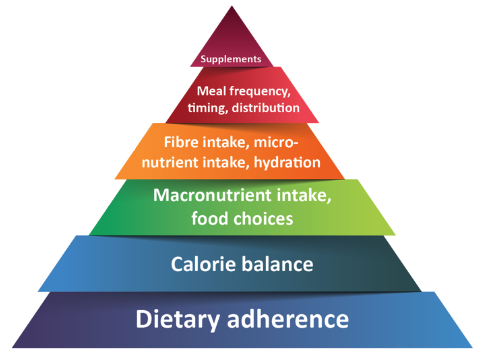What is important?
Nutrition can be looked at as an amalgamation of a multitude of topics, rather than as one single entity. It would be a mistake, however, to give all of these topics the same amount of ‘mental air time’ as they are not of equal importance. You only have a certain amount of time and mental energy with which to consider your nutritional practices on any given day, and by focusing too much on the small details you risk losing sight of the bigger picture.
So, what does that big picture look like? There are numerous ways to illustrate this and we are going to use a triangle which was first popularised by Eric Helms (to our knowledge) because nutritional importance is primarily hierarchical. This means that not only is level one more important than level two, but that without level one the rest of the hierarchy doesn’t really ‘work’ and would fall down. For example, looking at the pyramid below you could be optimally hydrated and making excellent food choices while consuming an ideal amount of protein, but if your calorie intake isn’t where it should be, then you’re still going to be unhealthy in the long run due to gaining or losing excessive amounts of weight, and you will not have the success you expect with your body composition.

You will notice that dietary adherence is the bottom tier. This will crop up a lot throughout this course because it is the single most important factor for long-term success. Adherence underpins everything, but it works both ways and the levels higher up in the pyramid can influence those lower down. The way you approach your nutrition, your food choices, calorie level, macronutrient distribution and fibre intake will directly impact on your adherence, and adherence will in turn, by definition, affect your decisions higher up the pyramid day-to-day. Starting out on a path to improved nutrition is often exciting for people because we are anticipating looking and feeling better, being more confident and (at the root of it all) feeling happier. But 3 weeks down the line when your end-goals haven’t magically appeared and you have only the day-to-day activities of your approach to consider, it can often become a little deflating.
People often want a flat stomach or a 6 pack, they want to look great on the beach and feel amazing about themselves, but all that is months away and the reality is that right now you’re stood in your kitchen drinking a smoothie. You aren’t close to your goal yet so you aren’t motivated by that, and the excitement of starting something new is gone, too. If the process itself doesn’t excite you, you will not stick with it long enough to reach the outcome.
Dietary adherence is something that most people are aware of as important. Unfortunately, we often only pay lip service to this when coming up with an approach. We’ve all said at some point “I have to be able to stick to it”, and we all know in theory that someone who crash diets will more than likely gain their weight back and we all know that ‘it’s supposed to be a lifestyle change’, but do we really act upon that?
Dietary adherence simply means consistently being on track which of course, in the context of the above definition of health, means that we need to define a track which maintains your social life, reduces stress on your part and doesn’t become overly restrictive while also helping you keep your overall physical health in top condition. This requires some degree of flexibility, but we will get to that later. For now, remember that adherence underpins everything and we will return to this in a later module.
As a final note on the pyramid of nutritional importance, we would like to indicate that some aspects, for example your micronutrient intake, are incredibly important for health. In fact, if you are chronically deficient in some micronutrients (that’s vitamins and minerals) you could die – but they appear higher in the pyramid because if you take care of the lower levels (food choice and macronutrients, primarily) then micronutrients will more or less take care of themselves. This pyramid loosely indicates what the key factors are in achieving health through nutrition, but it more accurately depicts the amount of energy and effort you should give over to each aspect of your nutritional approach to make sure you are doing everything ‘right’. The amount of energy and time you need to spend on something doesn’t necessarily relate to its importance – how often do you consciously make sure that your rate of breathing is appropriate for your oxygen needs?
In short, pay attention to the lower levels of the pyramid more than those above, because it’s the former that gives you the most return on investment. Once you have it in line, the latter only needs to be given a small amount of thought as it’ll be largely taken care of by default. Of course, it tends to be the things higher up the pyramid which appear to be more interesting because they come closer to being a ‘secret ingredient’.
Human beings have evolved to be problem solvers – if you give someone a task, while some of their brain is concentrating on doing it, the other will be almost automatically trying to come up with an idea to make it easier. This is why we use tools. Unfortunately, this leaves us vulnerable to falling for promises of ‘quick fixes’ and ‘magic bullets’ when it comes to our nutrition. We would love it if there was a one-line answer to improving your health, but it simply doesn’t work that way.
So – let’s look at the second wedge of our pyramid.